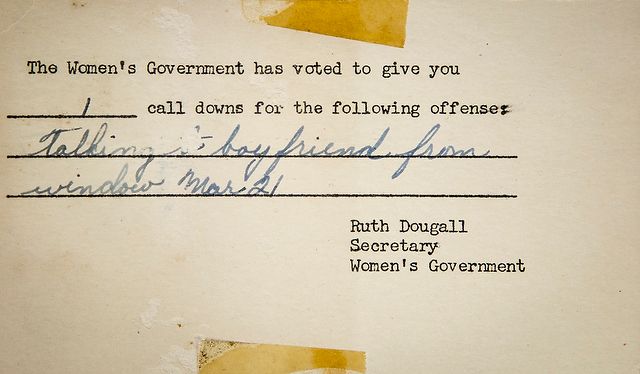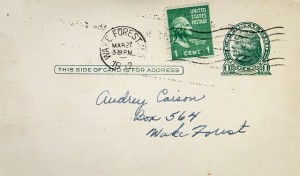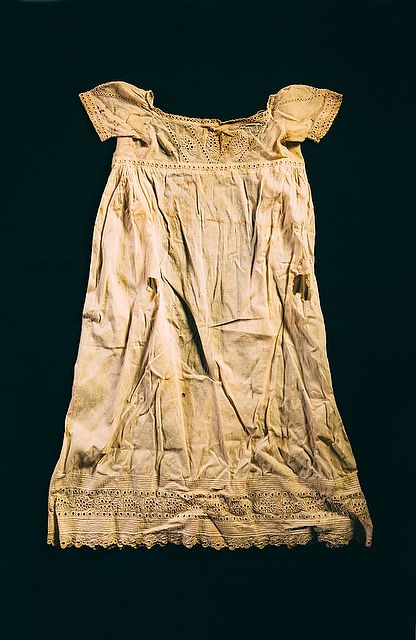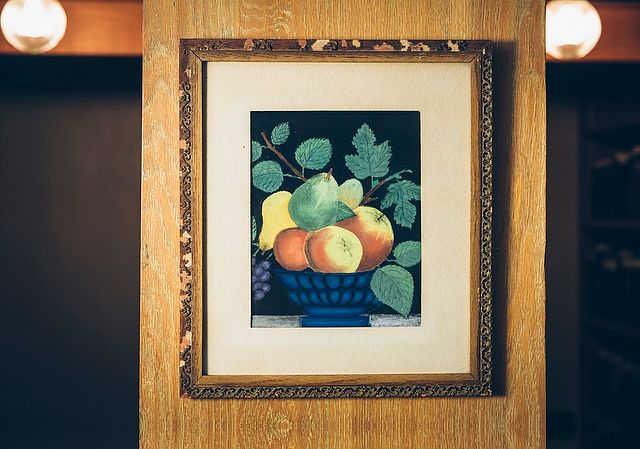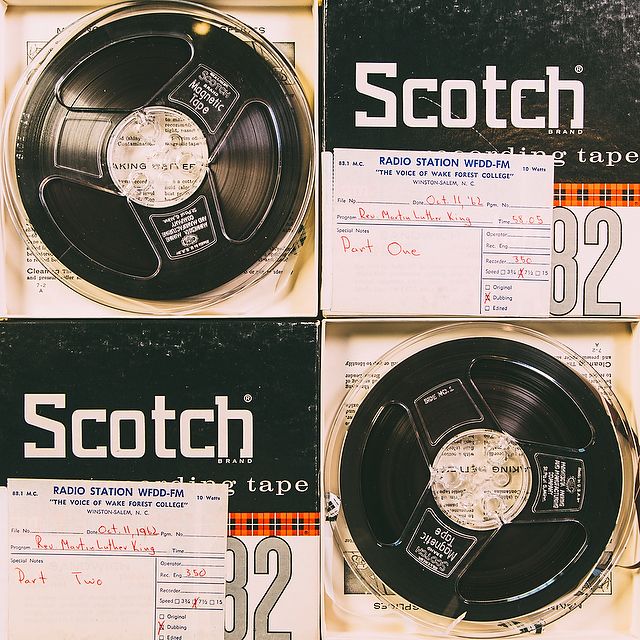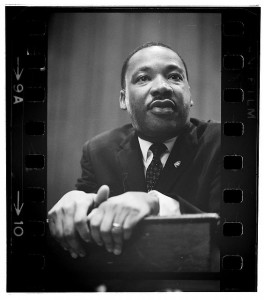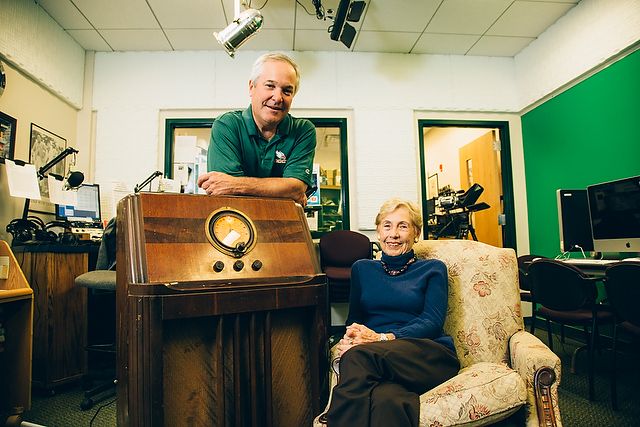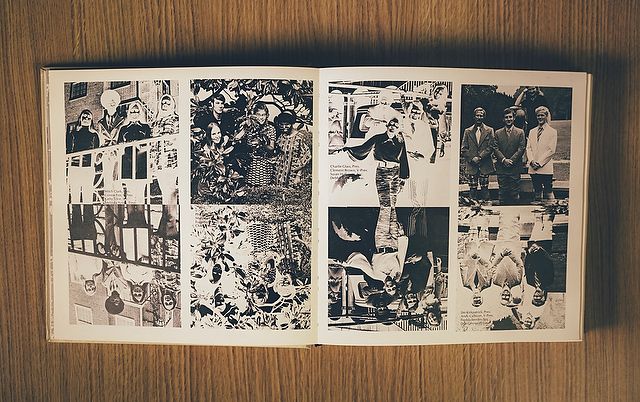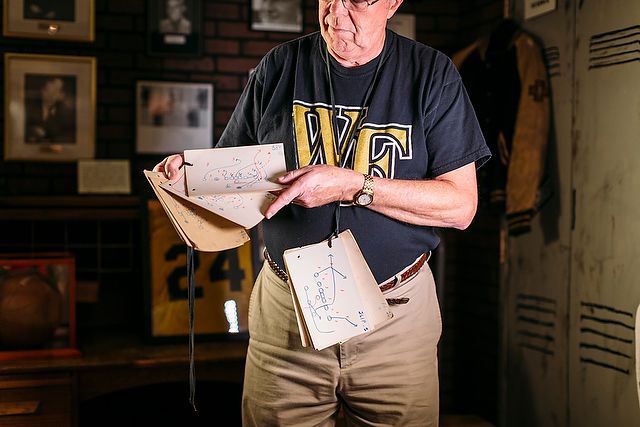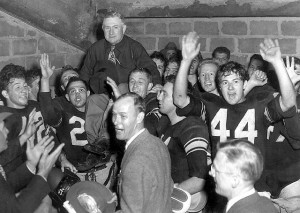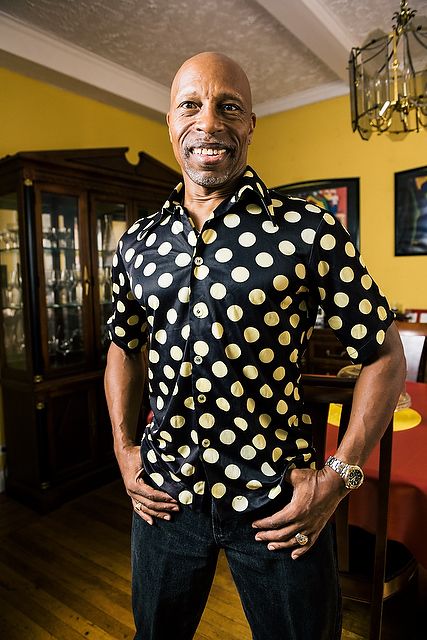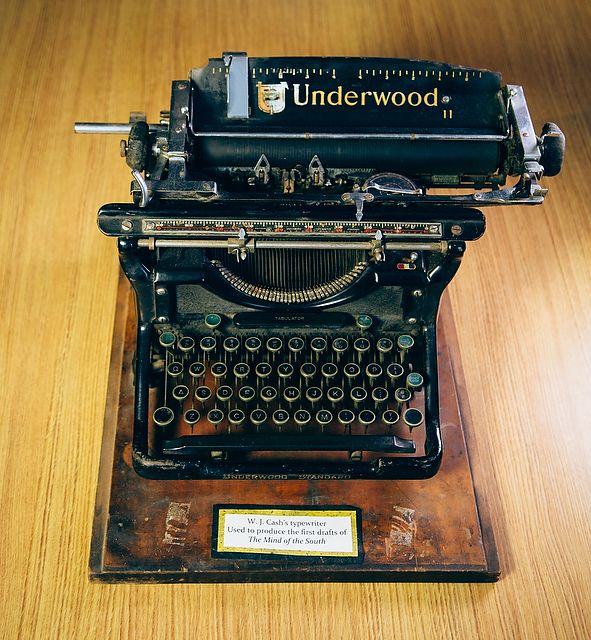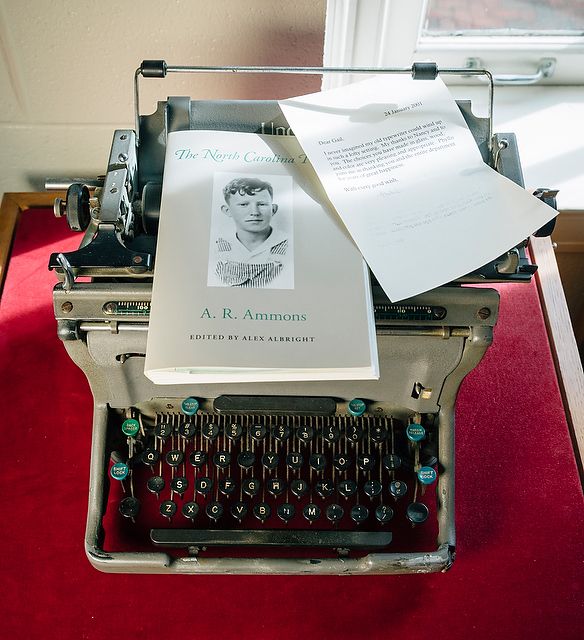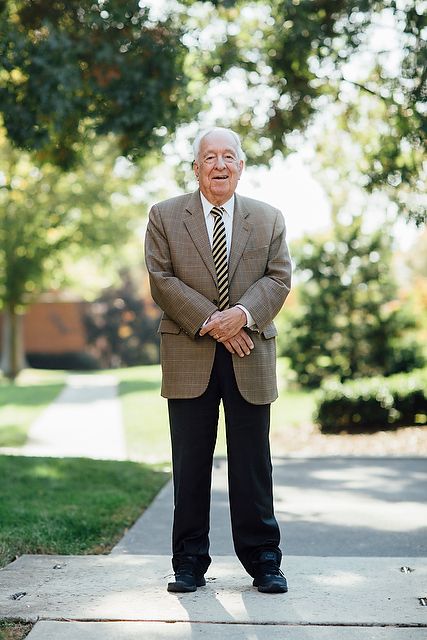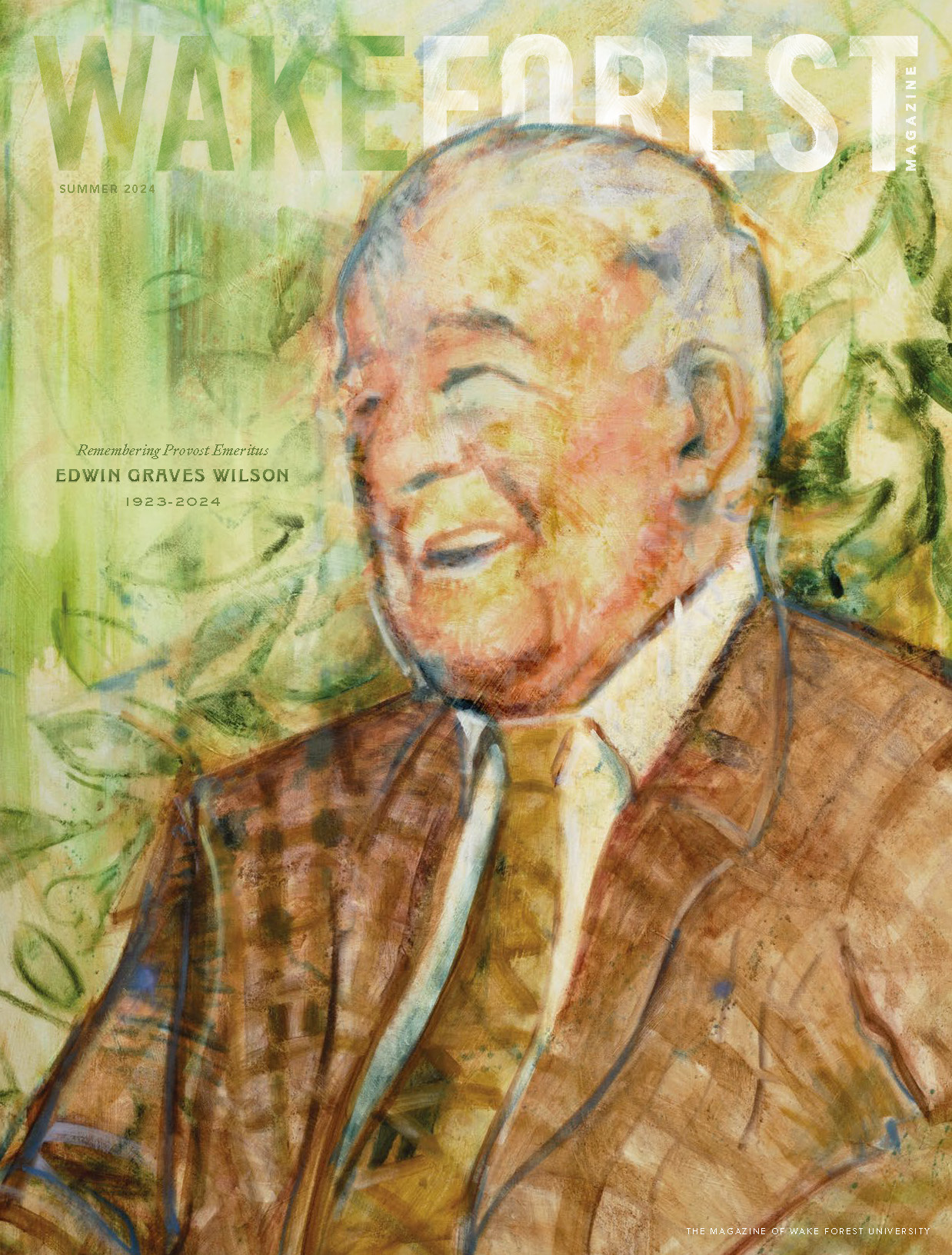After hearing from alumni with their generous suggestions and seeking advice from the campus community, Wake Forest Magazine curated this random collection of objects, from the whimsical to the serious and the historic to the fleeting (dress codes, anyone?). This assemblage humbly offers a few answers — but by no means a complete list — to an endless inquiry: What things make Mother so dear, not to mention fascinating?
THE BAD-NEWS POST CARD
“The Women’s Government has voted to give you 1 call down for the following offense: Talking to boyfriend from window Mar 21.” Harrumph. Many of Audrey Caison Bridger’s (’52) memories revolve around a boy she met her sophomore year, Dewey Bridger (’52). “He swept me off my feet,” she said. Once, when Dewey (who became her husband) arrived to pick her up for a date, she leaned out her second-floor window in Johnson dorm to tell him she was on her way. In 1952 that was enough to earn her a “call down,” or demerit, news of which came days later on a now-yellowed, typed postcard with the penalty handwritten in ink, so she knew it was serious. Back then too many call downs and you’d be “campused,” or restricted to campus for a certain amount of time.
According to historical documents, offenses such as failure to sign out or cooperate with fire drill regulations merited (or should we say de-merited) one call down; failure to attend dorm or compulsory Women’s Government Association meetings received two. Should you fail to notify the House Mother after NOT signing out on an overnight slip, date in excess of three date nights if you were without a C average, or date on a non-date night, you were on perilously thin ice and likely to be “campused” accordingly. “Times were so different,” Bridger said, simply. Still, in the words of Sophocles, “No one loves the messenger who brings bad news.”
SALLY WAIT’S ART
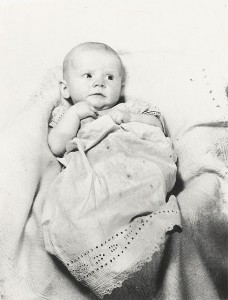
Harriet Bruce Dodd in her great-great-grandmother’s gown in 1942. Photo Courtesy Wake Forest Historical Museum.
Sarah “Sally” Merriam Wait (1794-1871), wife of Wake Forest founder and first president Samuel Wait, shared his strength of character and supported her husband’s work and ministry, both financially and emotionally. While many artifacts associated with Samuel have been passed down over time, two reflect Sarah’s artistic talent: a handmade christening gown and a still-life painting of fruit. The infant christening gown of Ann Eliza Wait, born in 1826, is stored at the Wake Forest Historical Museum on the Old Campus. Ann Eliza was the only surviving child of Samuel and Sarah, and she was born the year Samuel went south to begin his missionary work. The now-yellowed gown is in extremely fragile condition and scheduled for an eventual full textile restoration, a costly and time-intensive procedure. Sarah’s painting of a bowl of fruit, still in its original but deteriorating frame, was presented to the University by Misses Ellen and Ann Eliza Wait Brewer. It is included in the Samuel and Sarah Wait Collection of the Z. Smith Reynolds Library Special Collections and Archives.
ARNOLD PALMER’S RECORD ALBUM
The Grip. The Stance. The Woods. The Irons. Chipping and Putting. In 1962, Arnold Palmer (’51, LL.D. ’70) was a household name for Wake Foresters and serious golfers alike. But he wasn’t making house calls, so the best way to get a few golfing pointers from the master was to get your golfing gloves on a newly released album featuring instructional photos and lessons scripted by Arnie himself. The two-record set, a copy of which is in the Wake Forest Historical Museum, is still available for purchase online. “If I put this record on right now what’s the best piece of advice I’m going to hear?” asks Rich Lerner of The Golf Channel in a video interview after touring Palmer’s personal warehouse. “You’re going to get the fundamentals,” replies the legend, “and the basic fundamentals are going to involve everything in the golf swing.” Lerner says the LP, narrated by veteran broadcaster Chris Schenkel, is the most fascinating item he found in Palmer’s extensive collection of mementos. “To think that nowadays we can pull out the iPhone and download a lesson,” he says. “Arnold was dispensing advice in the 1960s via the LP.”
“TIMAEUS PENTAGON,” AKA THE TRIANGLE SCULPTURE
Tranquil, solid, triangular sits the eight-ton COR-TEN steel sculpture on the lawn near the Scales Fine Arts Center. Few today know the tempest surrounding its completion.
Robert Maki, a native of Walla Walla, Washington, was a Rockefeller Foundation artist in residence in 1978 for a program jointly administered by Wake Forest, Southeastern Center for Contemporary Art and the then-N.C. School of the Arts. With an initial $25,690 grant in 1979 by the National Endowment of the Arts designated for an outdoor sculpture on campus, Maki went about creating his “Timaeus Pentagon.” It cost about $52,000, mostly paid for by the NEA, says Provost Emeritus Ed Wilson (’43).
A number of students, professors — even President James Ralph Scales — were not pleased with the result. “I think it looks like something on a Putt-Putt miniature golf course,” said a freshman quoted in the Old Gold & Black in April 1981. “I thought it was a piece of junk left over from the construction,” said a senior. Professor of English John Carter said, “How can we expect public support of the arts when we put a howler like that on display?” According to Wilson’s fifth volume of University history, Scales said, “I’m going to live with it.”
Not everyone was critical. The art department faculty pointed to the sculpture’s beauty, simplicity, visual illusions and fine modern lines that complemented the Scales building. The artist himself has said the “triangles seem to shift visually as one walks or drives down the slope of the hill.”
Maki went on to create sculptures on various campuses around the country — from Stanford to Kent State — and public works that brought him acclaim, especially in the Seattle arts scene, perhaps best exemplified by his sculpture at the Seattle-Tacoma International Airport. Provost Wilson’s view: “I was satisfied. It didn’t anger me or excite me. … It’s like anything that’s been there for a long time. We treasure it because it belongs to history.”
MLK TAPES
Martin Luther King Jr.’s voice comes through clearly on the 53-year-old reel-to-reel tapes. He speaks of a day when “all of God’s children, black men and white men, Jews and Gentiles, Protestants and Catholics, will be able to join hands … and sing in the words of the old Negro spiritual, ‘Free at last! Free at last! Thank God A’Mighty, we’re free at last!’ ”
You’ve no doubt heard King’s 1963 “I Have a Dream” speech in Washington, D.C. But those tapes, in the Z. Smith Reynolds Library Special Collections and Archives, actually capture an earlier speech King delivered on Oct. 11, 1962 — at Wake Forest. That was 10 months before he used some of the same language in his “I Have a Dream” speech.
The College Union lecture committee invited King to campus. He was a well-known civil rights leader but not the international figure he would become after the 1963 March on Washington. He ate dinner in Reynolda Hall’s Autumn Room with about a dozen students — including Ed Reynolds (’64), the first black student to enroll at Wake Forest — before speaking in a packed Wait Chapel. WFDD recorded King’s speech on two reel-to-reel tapes, but the tapes were largely forgotten.
In 1998, Susan Faust, adjunct instructor of communication, and her husband, Associate Professor of Communication John Llewellyn, rediscovered the tapes in the library archives when they were researching King’s Wake Forest visit. “I remember the moment I found the speech,” Faust said. “I thought this could be something that no one has heard since it was given. To hear his voice — I could imagine him standing at the pulpit in Wait Chapel.”
BURROUGHS/HEIDTMANN 1938 RADIO
When Henry Heidtmann (’85) started teaching video production at Summit School in Winston-Salem in 1990, he proudly shared the news and his business card with his mentor, Professor of Speech Communication Julian Burroughs (’51, P ’80, ’83). Heidtmann kept up with him through the years until his death in 2008.
Last year, Burroughs’ widow, Jean, was downsizing to move to a retirement community. Among the items she thought needed a new home was a 1938 Philco console radio that Julian listened to as a boy growing up in Rockingham, North Carolina. Taped to the outside of the radio was Heidtmann’s 25-year-old business card. “I bet Henry would like to have this,” Jean thought.
She was right; Heidtmann was thrilled. Heidtmann is now an educational technology specialist at Summit, where he teaches radio, television and film production and the history of radio, all subjects Burroughs taught him at Wake Forest. The radio and an easy chair from Burroughs’ childhood home now sit alongside 21st century technology in Heidtmann’s classroom.
Heidtmann speculates about the radio’s past. Did it inspire Burroughs’ passion for radio? Burroughs was the first faculty manager of WFDD. Did it inspire Burroughs’ interest in the history of radio and the power of the medium? “He (Julian) could have listened to ‘War of the Worlds’ on this radio sitting in this chair,” Heidtmann said. “I make my students listen to ‘War of the Worlds’ just like I did in Dr. Burroughs’ class. I think they gain an appreciation for the history of radio and that it’s still a very valuable medium.”
Summit students are repairing the radio so that it will once again buzz with news and music. Heidtmann’s ultimate goal? To broadcast his students’ daily radio show on the Philco. What better tribute to his mentor, crossing generations and inspiring an appreciation for radio news of the now?
THE 1972 RELWOH
It was fabulous, righteous, groovy, funky and far, far out. Wake Forest had never seen anything like it.
Take a trip back to the ’70s. It was the Age of Aquarius, the counterculture movement, the anti-war movement and the beginning of the environmental movement. And the 1972 Howler was hip with the times. From its unusual size — square — you know immediately that it’s not your usual yearbook. Open it up and you’ll think you’re on a bad trip. The title page proclaims in huge type: WRONG WAY. And you are indeed reading it the wrong way; it reads from back to front.
 The yearbook opens with page after page of stock photographs of trees, leaves, birds, streams, waterfalls and a tattered American flag. Then come the ads and class portraits, followed by beautifully done large black-and-white photographs of faculty members, student activities and athletics, and color photographs of fraternity sweethearts. Just when you think you’re back in normal yearbook land come more stock photographs of streams and woods and flowers, with quotes from Thoreau.
The yearbook opens with page after page of stock photographs of trees, leaves, birds, streams, waterfalls and a tattered American flag. Then come the ads and class portraits, followed by beautifully done large black-and-white photographs of faculty members, student activities and athletics, and color photographs of fraternity sweethearts. Just when you think you’re back in normal yearbook land come more stock photographs of streams and woods and flowers, with quotes from Thoreau.
An epilogue — or is it a prologue since the back of the book is really the front of the book? — offers an explanation. “They call us the children of Aquarius. We read of poverty, disease, suffering, murder, and wars, but we glance away and hide in the Wake Forest Cloister … Our parents have bequeathed us one hell of a mess, but aren’t most of us passing on the bequest to our children? … Let us find again the best in ourselves and cherish even the minutiae of nature.”
However unorthodox the approach, the message of the ’72 RELWOH is as old as Pro Humanitate: a call to leave the Wake Forest Cloister, or Bubble as today’s students would call it, and improve the world. And the fact that we’re writing about a 44-year-old yearbook proves that whatever the editors were trying to do, one thing’s certain: They were geniuses unafraid of risk.
PEAHEAD’S PLAYBOOK
Douglas Clyde “Peahead” Walker was the most colorful football coach in Wake Forest history. The tough-as-nails coach led the Deacons to 14 mostly successful seasons and the 1945 Gator Bowl title. He coached from 1937 until 1951, when he resigned over a salary dispute. (It would be 60 years before another coach, Jim Grobe, tied Walker for the most victories in school history.)
While he was known for his sense of humor and stylish dress, Peahead also had a reputation for being a bit of a hothead. He incurred at least one reprimand from President Thurman Kitchin for salty language. “Aw, Dr. Kitchin,” Peahead replied, “damn to a football coach is like amen to a preacher.”
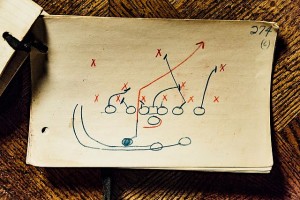 Peahead, who died in 1970, wore this playbook around his neck when he walked the sidelines of the original Groves Stadium in old Wake Forest. The playbook includes diagrams of 22 plays, uniquely numbered from 1-9-440 to 261P-3. (Two of his playbooks are at the Wake Forest Historical Museum.) After Coach barked out a play, any player who missed his assignment was sure to get an earful and a nickname — Hollow Brain and Butterfingers were two of his favorites — from the man who’s still known simply as Peahead.
Peahead, who died in 1970, wore this playbook around his neck when he walked the sidelines of the original Groves Stadium in old Wake Forest. The playbook includes diagrams of 22 plays, uniquely numbered from 1-9-440 to 261P-3. (Two of his playbooks are at the Wake Forest Historical Museum.) After Coach barked out a play, any player who missed his assignment was sure to get an earful and a nickname — Hollow Brain and Butterfingers were two of his favorites — from the man who’s still known simply as Peahead.
THAT ’70S GUY & HIS POLKA-DOTTED SHIRT
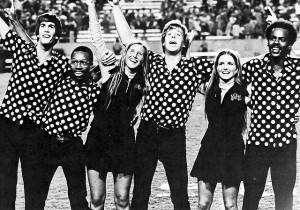 Jeff Dobbs (’77) is among the most popular Demon Deacons of all time. With his dance moves, impossibly limber head rolls and memorable entrances into Groves Stadium (via helicopter and Staley’s Bull), he put on a show on football Saturdays.
Jeff Dobbs (’77) is among the most popular Demon Deacons of all time. With his dance moves, impossibly limber head rolls and memorable entrances into Groves Stadium (via helicopter and Staley’s Bull), he put on a show on football Saturdays.
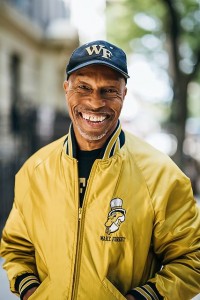 Then there was the shirt, a gaudy, black-and-gold-polka-dotted polyester number that would make your head spin if you stared at it too long. “It was certainly different from any other shirt,” Dobbs, a teacher, dancer and choreographer in New York City, says with some understatement. “No one else was wearing polka dots.”
Then there was the shirt, a gaudy, black-and-gold-polka-dotted polyester number that would make your head spin if you stared at it too long. “It was certainly different from any other shirt,” Dobbs, a teacher, dancer and choreographer in New York City, says with some understatement. “No one else was wearing polka dots.”
The polka-dotted shirt — along with a tan jacket with the Wake Forest seal, a yellow windbreaker with “Jeffro” on the pocket and a black letterman’s sweater with gold WF letters — are in Dobbs’ archive in his Upper West Side apartment. And, yes, he can still wear the shirt, pulling it out for at least one Halloween party. With bell-bottom pants, platform shoes, a gold peace necklace and an Afro wig, he traveled back in time, as an old-school, super cool ‘70s man, to this day a Demon Deacon legend in an unforgettable shirt.
TYPEWRITERS OF W.J. CASH (’22) AND A.R. AMMONS (’49, D.LITT. ’72)
Among alumni who have achieved prominence as authors, journalists and poets, W.J. Cash and A.R. Ammons are especially notable. Both were honored posthumously in 2012 as two of the inaugural inductees into the Wake Forest Writers Hall of Fame.
Cash wrote only one book before he died at age 41, but his acclaimed volume on Southern history, “The Mind of the South,” still resonates 75 years after its publication. Cash wrote his seminal work on this Underwood typewriter, now in the Z. Smith Reynolds Library Special Collections and Archives.
Ammons wrote nearly 30 collections of poetry and received numerous awards during his prolific 50-year career. He returned to Wake Forest in the mid-1970s for a year as the University’s first poet-in-residence. His Underwood typewriter is on display in the English department’s A.R. Ammons faculty lounge. “I never imagined my old typewriter could wind up in such a lofty setting,” Ammons wrote when he donated the typewriter in 2001, shortly before his death.
MR. WAKE FOREST’S SNEAKERS
On this day Ed Wilson (’43), provost emeritus and 92-year-old gentleman around campus, sports his black pair of Nike sneakers. “They feel so good and so comfortable,” he says.
About six years ago he began wearing sneakers after shelving his “ordinary wingtip shoes of the kind that administrators tend to wear.” His twice-a-week exercise trainer persuaded him to switch. Except for church, a funeral or more formal occasions he sticks with his sneakers.
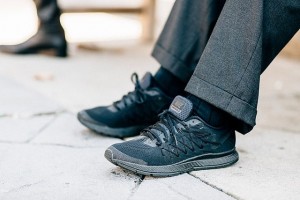 “Way back when I was young I had tennis shoes of some kind, but I’d never worn sneakers before. This was a change,” he says. “What really interests me about wearing these sneakers is how many people call attention to them, sometimes I’ve thought a little critically, as if I was not properly dressed for the occasion.” But he will walk on, comfortably, continuing to clock untold miles on the Old Campus and the new. He notes, “I haven’t given up my tie yet.”
“Way back when I was young I had tennis shoes of some kind, but I’d never worn sneakers before. This was a change,” he says. “What really interests me about wearing these sneakers is how many people call attention to them, sometimes I’ve thought a little critically, as if I was not properly dressed for the occasion.” But he will walk on, comfortably, continuing to clock untold miles on the Old Campus and the new. He notes, “I haven’t given up my tie yet.”

